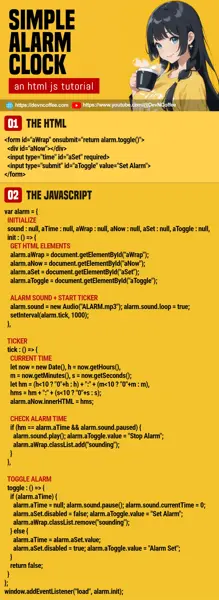Once upon a time, a student is tasked to create a “classic alarm clock web app” as an exercise. He confidently told Master Coffee that “it’s just an interval time”, but came asking for tips the very next day… So here it is, let Master Coffee walk you through a simple example. Let’s go.
CODE DOWNLOAD
I have released this under the MIT license, feel free to use it in your own project – Personal or commercial. Some form of credits will be nice though. 🙂
VIDEO TUTORIAL
ALARM CLOCK DEMO
PART 1) THE HTML
<form id="aWrap" onsubmit="return alarm.toggle()">
<!-- (PART A) CURRENT TIME -->
<div id="aNow"></div>
<!-- (PART B) SET ALARM -->
<input type="time" id="aSet" required>
<input type="submit" id="aToggle" value="Set Alarm">
</form>This should be pretty self-explanatory.
<form id="aWrap">A form to set the alarm, and doubles up as the alarm clock wrapper.<div id="aNow">To display the current time.<input type="time" id="aSet">Time picker to set the alarm time.
PART 2) THE JAVASCRIPT
var alarm = {
// (PART A) PROPERTIES
sound : null, // alarm sound
aWrap : null, // html alarm clock wrapper
aNow : null, // html current time
aSet : null, // html set alarm time
aToggle : null, // html toggle alarm button
aTime : null, // set alarm time
// (PART B) INITIALIZE
init : () => {
// (B1) ALARM SOUND
alarm.sound = new Audio("ALARM.mp3");
alarm.sound.loop = true;
// (B2) GET HTML ELEMENTS
alarm.aWrap = document.getElementById("aWrap");
alarm.aNow = document.getElementById("aNow");
alarm.aSet = document.getElementById("aSet");
alarm.aToggle = document.getElementById("aToggle");
// (B3) TICKER
setInterval(alarm.tick, 1000);
},
// (PART C) TICKER
tick : () => {
// (C1) CURRENT TIME
let now = new Date(),
h = now.getHours(),
m = now.getMinutes(),
s = now.getSeconds();
// (C2) SHOW IN HH:MM:SS FORMAT
let hm = (h<10 ? "0"+h : h) + ":" + (m<10 ? "0"+m : m),
hms = hm + ":" + (s<10 ? "0"+s : s);
alarm.aNow.innerHTML = hms;
// (C3) CHECK ALARM TIME
if (hm == alarm.aTime && alarm.sound.paused) {
alarm.sound.play();
alarm.aToggle.value = "Stop Alarm";
alarm.aWrap.classList.add("sounding");
}
},
// (PART D) TOGGLE ALARM
toggle : () => {
// (D1) STOP ALARM
if (alarm.aTime) {
alarm.aTime = null;
alarm.sound.pause();
alarm.sound.currentTime = 0;
alarm.aSet.disabled = false;
alarm.aToggle.value = "Set Alarm";
alarm.aWrap.classList.remove("sounding");
}
// (D2) SET ALARM
else {
alarm.aTime = alarm.aSet.value;
alarm.aSet.disabled = true;
alarm.aToggle.value = "Alarm Set";
}
return false;
}
};
// (PART E) START
window.addEventListener("load", alarm.init);This can be a little intimidating for the beginners, but trace through in this order:
- We create an
var alarm = { ... }object to contain all the mechanics. - (E & B) On window load, we call
alarm.init()to initialize the “alarm clock widget”.- (B1) Create a
new Audio()object to play the alarm sound, set the alarm to loop infinitely. - (B2) Get the HTML elements.
- (B3) Create an interval timer, call
alarm.tick()every second.
- (B1) Create a
- (C) This will deal with “show the current time” and “sound the alarm”.
- (C1) Get the current time – The hour, minute, seconds.
- (C2) Display the current time in the HTML, in a “nice pretty format”.
- (C3) This part works in tandem with (D)
alarm.toggle().
- (D) Deals with the alarm.
- (D2) On clicking the “set alarm” button, we will set the selected time into
alarm.aTime. - (C3) When the “current time matches
alarm.aTime“, we sound the alarm. - (D1) Clicking on the button again will stop/disable the alarm.
- (D2) On clicking the “set alarm” button, we will set the selected time into
PART 3) THE CSS
/* (PART A) WHOLE PAGE */
* {
font-family: Arial, Helvetica, sans-serif;
box-sizing: border-box;
}
/* (PART B) ALARM CLOCK WRAPPER */
#aWrap {
text-align: center;
max-width: 400px; padding: 20px;
border-radius: 10px;
border: 2px solid #ececec;
background: #f7f7f7;
}
#aWrap.sounding {
border: 2px solid #fcd0d0;
background: #fff6f6;
}
/* (PART C) CURRENT TIME */
#aNow {
font-family: Impact, Haettenschweiler, 'Arial Narrow Bold', sans-serif;
font-size: 48px;
margin-bottom: 20px;
}
/* (PART D) SET ALARM */
#aWrap input { padding: 10px; border: 0; }
#aSet:disabled { background: #c1d0ff; }
#aToggle {
color: #fff; background: #1d53b4;
margin-left: 20px; cursor: pointer;
}Lastly, these are just some CSS cosmetics for the alarm clock. Feel free to style the alarm clock however you wish.
THE END – NOT SO PRACTICAL & ALARM SOUNDS
That’s all for this quick tutorial. A quick note before we end – It is impossible to run web apps in the background at the time of writing. That is, the alarm clock page must be kept open. Anyway, there are plenty of “free sound effects” sites to download more alarm sounds. But be careful the licenses, some are “free for personal use only”. Here are a few sites that provide “free for commercial use”:
CHEAT SHEET

